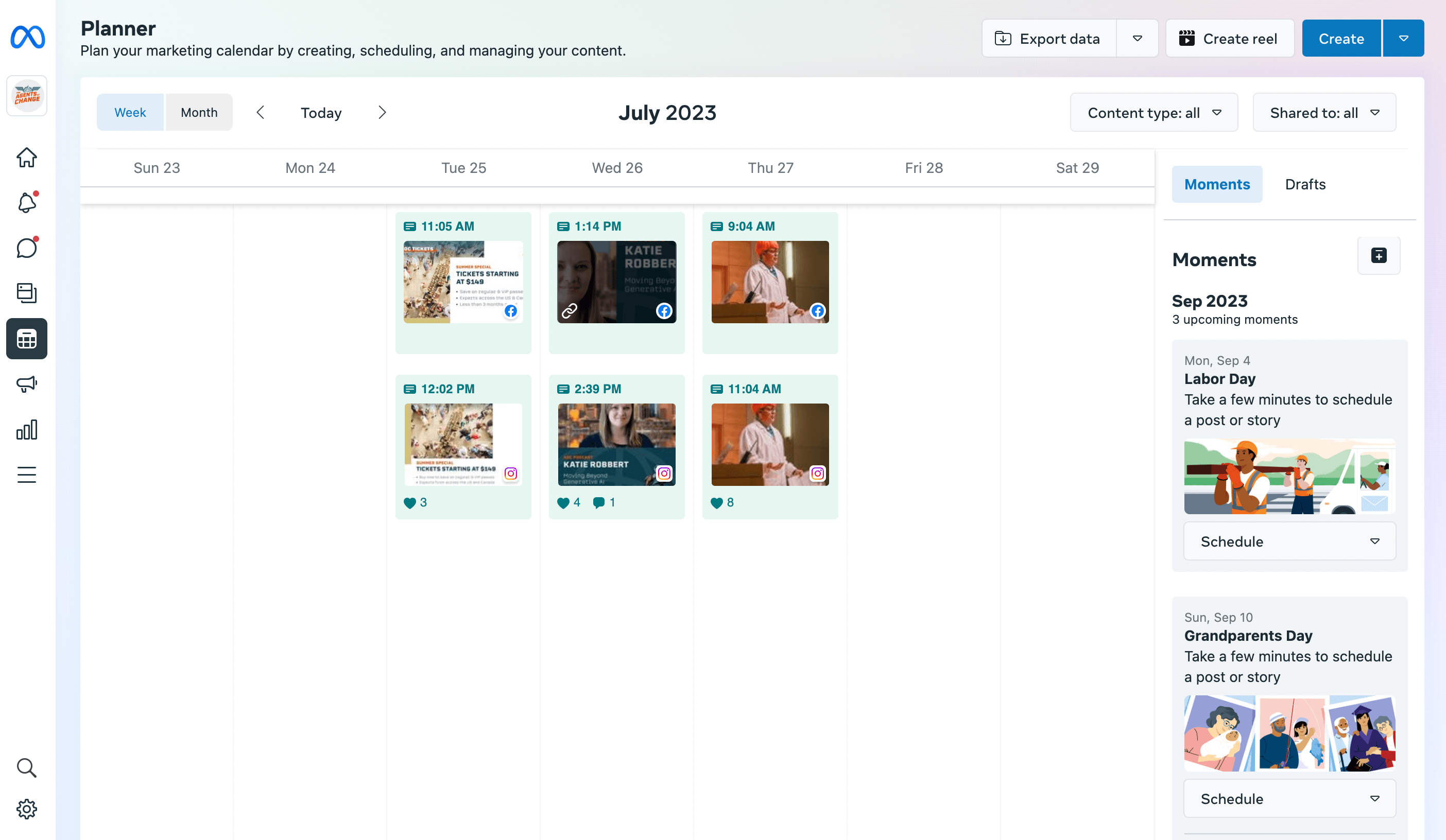 My word of the year is intentional. Down with purchasing kitchen gadgets I don’t need, down with beating around the bush when making plans with friends, and down especially with marketing just for marketing’s sake.
My word of the year is intentional. Down with purchasing kitchen gadgets I don’t need, down with beating around the bush when making plans with friends, and down especially with marketing just for marketing’s sake.
Content marketing is key to reaching your top of funnel audiences, building trust, developing relationships with your customers, and a host of other benefits. But even for many of the business owners and marketers who understand its value, content creation is often treated as a box to check with an improvised strategy–flying by the seat of your pants, as we call it at flyte. They’ll throw up a blog with a few paragraphs (and maybe more than a few spelling errors) or post stock images on their company social media accounts because hey, that counts, right?
You’re not alone, I’ve lost count of the number of times I made a generic Instagram post for flyte–sorry, Rich–because I had more pressing work to attend to like creating content for our clients! I checked off the box, but the data will tell you that your slapdash content doesn’t actually produce engagement, traffic, increased ranking or leads. But as always, the problem of where to find the time remains. I’ve got a solution…
Why Do I Need Content Planning?
You need a content calendar. Not because you’re about to become the next influencer but because you need to leverage content marketing in a way that is both effective and efficient.
Earnest content planning with tools like a blogging content calendar or a social media content calendar accomplishes this in a few ways:
- It forces you to set aside dedicated, focused time to your brand’s content, resulting in higher quality posts, blogs, emails, and more.
- It creates accountability for you and your team by assigning roles and dates.
- It keeps you consistent and helps you avoid delays or radio silence when your other work gets busy.
- It allows you to execute swiftly, taking only a few minutes (and little brain power) to publish pre-planned content.
- Finally, its more standardized process help you collect valuable data on what does and doesn’t resonate with your audience, so you can continually improve your marketing, your results, and your bottom line.
What is a Content Calendar?
I’m kicking myself for saying this, but it depends. One of the benefits of content planning tools is that they are designed and adapted to your needs. But in essence, a content calendar provides structured space for you to lay out some type of creative content for a certain period of the future.
Like other project management strategies, a content calendar can be used for lots of different things:
- Social Media
- Blogs
- Email Newsletters
- Events
- Videos
- And more!
How far in advance you plan your content is totally up to you and your team’s workflow. Even planning a week ahead for smaller tasks like social posts can streamline your daily responsibilities. At flyte, we like to keep a 6 month blogging content calendar and a 1 month social media content calendar. If you’re using a content calendar for the first time, it may take a while before you dial in what depth and breadth of content planning will make the biggest impact for your business.
Manual Content Calendars vs External Content Planning Tools
We’re certainly not the first ones to come up with the idea of using content calendars to streamline the creation and publishing process. There are lots of companies that have built software exactly for this purpose. Here are a few examples of companies that provide digital content planning tools:
These are just a few of the out-of-the-box content marketing tools you can find online, and we think each of them is great for different reasons. But many of these tools have monthly fees, and they may not have all the features you’re looking for–or they have too many features, making them difficult to use.
The alternative is to create a manual content calendar that you can customize to your needs. Spreadsheets or word documents work great, ensuring the product you end up with is simple and built just for you. If you use a file sharing service like Google to create these documents, you can also share them live with other team members, add comments, track edits and access them from anywhere.
That’s not to say that one tool for content planning is better than the other. In fact, we use a combination of external software and internally built Google sheets to plan and implement our creative content. You can demo or trial most content planning softwares for free so consider researching and testing a few options.
The rest of this blog will focus on how to build and use a spreadsheet calendar.
Building Your Own Content Calendar Spreadsheet
You don’t need to be a spreadsheet wizard to make a beautiful content calendar, and you definitely don’t need to start from scratch! A quick Google search will find you hundreds of free spreadsheet templates to get started with. We like this one from Vertex42 for planning and tracking copywriting projects.

Being careful not to delete essential components of the calendar formula, you can add or remove columns, change dropdown menu options, customize colors and so on.
Before you build, think about what the ideal process and steps are for completing a creative project like blogging. Is there a research stage that comes before drafting? Does the blog pass through multiple hands for edits or approval? Is there follow up content like an email newsletter after it’s published? Even if these steps aren’t followed exactly every time, it’s important that your content calendar has a place for them. In all likelihood, the calendar structure you start with won’t be the same as the one you’re using six months or even a year from now.
For our social media, we created our own spreadsheet template which you can view and copy here. In one month blocks, this calendar allows us to plan all elements of our company’s social presence, including:
- The images and captions for each separate channel
- The URLs we’re driving traffic to, if appropriate
- The publishing date
- and so on.
The idea is to fill in the calendar before the turn of each new month. By dedicating up front time for social content, we nudge our brains into more creative and focused thinking and save ourselves time down the line.
This calendar includes three important columns that help us maintain this efficiency: content type, image type, and title/theme. When creating our social media content calendar, we thought deeply about the different categories our posts tend to fall under and the various image templates we use regularly. This reflection led to drop down menus with the common options for each.
 Even in busy times when social media feels like the last thing on our minds, these three categories allow me and Rachel, our Google Ads Specialist, to sit down for just an hour and sketch out a month’s worth of social posts. We may not fill in every detail in that planning meeting, but using those 3 columns lets us quickly categorize the things we want to promote, ensure there’s variety in our content, and make it clear what assets will be needed to execute.
Even in busy times when social media feels like the last thing on our minds, these three categories allow me and Rachel, our Google Ads Specialist, to sit down for just an hour and sketch out a month’s worth of social posts. We may not fill in every detail in that planning meeting, but using those 3 columns lets us quickly categorize the things we want to promote, ensure there’s variety in our content, and make it clear what assets will be needed to execute.
Better yet, at the end of the month when we are evaluating the results of our social posts, we can use these categories to identify patterns in engagement. Are posts featuring our staff members getting the most reactions and comments? Let’s up the ante next month. Did that graphic with a statistic result in more clicks to a new blog than the graphic with a quote? Great, we’ll try using those more often when promoting future blogs.
Bonus Content Calendar Tips
If you use a spreadsheet like the ones I describe above, it can include other tools to streamline your content creation. For example, you could have tabs for each of your content channels: social, website, email, etc. providing the perfect way to synchronize your content marketing.
Our social media content calendar also has a tab that contains a bank of commonly used hashtags so that we can easily copy and paste relevant ones into our captions. You could include a list of important holidays, staff birthdays or work anniversaries, different audience personas, a list of external resources that are great for finding statistics, helpful articles or inspiration… I could go on.
By putting all these tools in one central location, you not only make it easier to use them but also make your resulting content higher quality. Predict the roadblocks to content creation and put resources in place that can help you overcome them.
Content calendars also help you see where there are gaps in your content or make space to be spontaneous–placeholders can sometimes be just as useful as fully planned items!
Executing Your Content
Now that you’ve planned your content, it’s time for the “easy” part–implementation. In some cases, like with social media, fully planned posts can be scheduled directly in the social platforms (some have built in content planners, like Meta Business Suite) days, weeks or even months ahead.
Use due dates to keep your team on track for longer form content like blogs or email newsletter copy. And most importantly, use your content calendar to build habits around content creation so that you can spend more time focusing on the creative part and less time on the logistics.

Fair warning, as good as these content planning tools sound, they aren’t 100% effortless. As with any new skill it will take time and dedication to develop and master your content calendar. But embracing intentionality in your content marketing can have great long term payouts. My best advice is to stick with it.
Want someone to build a personalized content calendar for your business and fill it with authentic, strategy driven content? Whether you just need a launching pad or you want an experienced pilot to lead your content marketing down the runway and into the skies, flyte can help. Reach out to chat with us about digital content planning services to boost your brand awareness, site traffic and audience trust.

Izzy joins flyte after moving to Portland in 2020, a city that is affably similar to her beloved Burlington, Vermont, with the added benefit of ocean air and fresh seafood. With a degree in English and a background in the nonprofit sector, she carries a curiosity for all things communications. From social media and email newsletters to website management and SEO, Izzy is involved. Reach out to Izzy today!
